The Jesus Report Is Out!
(a 1300 page document, with only minor redactions)
on ‘The Ego’s Conspiracy’ to keep us locked in believing in separation:
Here’s The…
https://www.youtube.com/watch?v=74dg-WfhsjA
School for A Course In Miracles
"The universe of learning will open up before you."
https://www.youtube.com/watch?v=74dg-WfhsjA



If you don’t see yellow “Donate” link above, click here for link
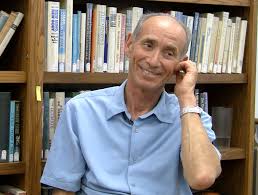

One of the major themes that we will be talking about is joining, what it is, and what it is not. The end of workbook lesson #92 discusses this. To the ego joining always means joining with itself. We discussed how in the original ontological instant when the decision maker had to make his choice, he joined with the ego instead of with the Holy Spirit. From that joining, which is really a pseudo-joining, because it is joining with nothing, the whole world is made. We continually join with this limited and separated self that is the ego. In the world, the limited and separated self is no longer in the mind but is in the body, and so joining for us in the world is joining with other people. There is an important line in the text that says “minds are joined; bodies do not” (T-18.VI.3:1). Bodies do not join. When we find ourselves in sympathy and empathizing with people who are in pain, or identifying with a particular group against another group, we are identifying and joining with their bodies. That is not joining, because we are joining with an illusion. We are joining with weakness instead of strength.
In true joining, we change our minds and move away from the ego and back to the Holy Spirit. That is the meeting place that lesson #92 talked about, the meeting place of the little “s” self with the capital “S” Self. The capital “S” Self is represented for us in the dream by the Holy Spirit, Who reminds us of the Self we are as Christ. The little “s” self is the self that believes in separation. When the decision maker moves away from identifying with the ego self and begins to move towards the Holy Spirit, that is the meeting place. The meeting place is within the mind, the decision-making part of the mind that chooses to identify and join with the Holy Spirit. When we join with Him there is no separation. As we said earlier, the ego believes in separation, difference, judgment, and attack, and they all are virtually the same thing. In fact, not only virtually, they are the same thing. When we join with the Holy Spirit we are joining with the unity of God and Christ. We are joining with the love of Heaven that has no division or differentiation to it. Then when we peer out into the dream we no longer experience differences or separation. As I mentioned earlier, whatever is on the film that is running through the projector in the movie theater is exactly and identically what we perceive on the screen. So, too, when we join in the mind with the Holy Spirit, which is joining with the unity of Christ, we experience unity and love on the screen of our lives, in the world. It does not mean the body’s eyes will not perceive differences, but the differences will make no difference. In other words, the Love of God that we are now identifying with is totally unaffected by the seeming differences that the body’s eyes perceive.

That is what Jesus means in the passage at the end of Chapter 15, which was written at New Year’s time as a kind of New Year’s prayer: “Make this year different by making it all the same” (T-15.XI.10:11). In other words, don’t make differences real. Chapter 15 is the first place in the text where Jesus discusses special relationships. And the hallmark of specialness is differences: You are different from me, you have something that I want, and I want to get it from you. When we join with the Holy Spirit or with Jesus in the mind, we no longer experience differences. If we no longer experience a difference between ourselves and the Love of God, it is impossible to experience any real difference out here in the world. We do not see people as separate and different from us, and therefore we make no judgments against them and we don’t attack.
“The Greater Joining”—the title of the section we will look at later—is this joining of Christ with Himself, or the joining of Christ with God. We do that first in the mind, and automatically the vision and unity and experience of love extend through us into the dream, and we no longer experience people as different from us. No matter how mangled their bodies may be, no matter how much in pain they are, no matter how terrible their situations are, we do not experience ourselves as different from them. We will go into all that in more depth later on.

(By Tim Wise)
As I was planning to do a Thursday Chat about arrogance and humility, I did what I do on any topic and started with Webster. On arrogance, the dictionary definition is “being full of excessive and overbearing pride.”
With humility, Webster sounds like the Course: “having or expressing a sense of selflessness.” Really, that’s what it says. That’s the #1 definition that’s used the most in everyday English for being humble… letting go of our sense of ‘lower-case’ self.

A couple of my own ideas about arrogance, for me anyway… include a few things:
1) It has a puffed-up unwarranted overkill about it, like a balloon full of hot air.
2) Arrogance is not very likable, if not mostly distasteful. My sense is even the arrogant don’t like it in others.
3) Finally, arrogance needs an audience. It demands an internal belief that others are acknowledging the arrogant’s superiority, whether it’s true others are really noticing or not.

For humility, I would agree with Webster on an attitude of selflessness. I would also add the Course’s principle that the truly humble focus on shared interests in the mind, and let go of their investments in the seeming external differences.
The Course actually uses the words arrogance/arrogant 55 times, and humility/humble over forty. Whenever arrogance is spoken about in the Course, it is always in relationship to its opposite, humility. The two themes are covered for the most part in Lessons #61, 152, and 186. “True humility” is especially described as the top of the ladder of prayer, in the Song of Prayer Pamphlet, p. 8:
Prayer (defined in the Pamphlet as not supplication to the Holy Spirit for specifics, but as a state of communion with the HS) is the way to true humility… and true humility will come at last to grace the mind that thought it was alone and stood against the world… Its selflessness is Self… Humility has come to teach you how to understand your glory as God’s Son, and recognize the arrogance of sin.
(Excerpts from Song of Prayer p. 8)
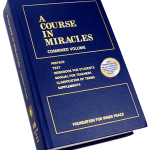
Some Course thoughts from Les.#61…
Who is the light of the world except God’s Son? This, then, is merely a statement of the truth about yourself. It is the opposite of a statement of pride, of arrogance, or of self-deception. It does not describe the self-concept you have made. It does not refer to any of the characteristics with which you have endowed your idols. It refers to you as you were created by God. It simply states the truth.
To the ego, today’s idea is the epitome of self-glorification. But the ego does not understand humility, mistaking it for self-debasement. Humility consists of accepting your role in salvation and in taking no other. It is not humility to insist you cannot be the light of the world if that is the function God assigned to you. It is only arrogance that would assert this function cannot be for you, and arrogance is always of the ego.
True humility requires that you accept today’s idea because it is God’s Voice which tells you it is true. This is a beginning step in accepting your real function on earth. It is a giant stride toward taking your rightful place in salvation. It is a positive assertion of your right to be saved, and an acknowledgment of the power that is given you to save others.
( WB, Les 61, p. 102, par.1-3)
Arrogance and humility are simply about how we see ourselves… we either are “the light of the world” we perceive, or we’re not. Our identification as separated egos insist on the latter. We believe we have done the impossible (a great definition of arrogance), and separated from our Father in Heaven. Now we believe we are these inflated balloons full of hot air (bodies), that will eventually deflate (die). How silly is that!
Of course, our ego would like to run in its own direction, relentlessly maintaining belief in separation. It would use all the above Course statements its own way, especially “the power that is given you (us) to save others.” The ego would make it all about separate bodies saving other separate bodies, especially my body/personality saving yours. However that power to save (i.e. wake up from the dream of separation) is never, ever, played out in the world behaviorally, or by the separated us at all.

Whatever happens in the world is always a mirror reflection of two (and only two) chosen thoughts or chosen teachers in the mind, the ego or Holy Spirit… If we are choosing the inner ego voice of belief in separation in our minds, whether we act like Crusader Rabbits (a cartoon from the 1950’s) saving anyone or everyone in the world, it will always be a refection of that teacher in our minds.
Whenever our behavior is reflecting an inner ego choice, any worldly act of kindness/salvation cannot help but be an act of arrogance! Full of hot air and blown-up pride. It typically manifests as… “I am Holier than tho, and I will save you, the lesser.”

These ego-based “kind” actions certainly have the ring of the three ideas above about arrogance:
—————————

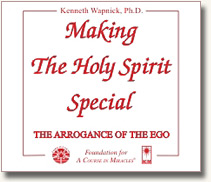



How can you know whether you chose the stairs to Heaven (HS) or the way to hell (the ego)? Quite easily. How do you feel? Is peace in your awareness?
Are you certain which way you go? And are you sure the goal of Heaven can be reached? If not, you walk alone. Ask then your Friend (HS) to join with you, and give you certainty of where you go.
(Text Ch. 23, p.494, par.22)
How can you tell when you are seeing wrong, or someone else is failing to perceive the lesson he should learn? Does pain seem real in the (my) perception? If it does, be sure the (my) lesson is not learned.
And there remains an unforgiveness hiding in the (my) mind that sees the pain through eyes the mind directs.
(WB Les. 193, par.7)
Over and over the Course tells us that the way we save the world is by realizing that we and the world are already saved. The Course’s Introduction to the Text resounds throughout the entire Course:
The Course does not aim at teaching the meaning of love, for that is beyond what can be taught. It does aim at removing the blocks to the (our) awareness of love’s presence, which is your natural inheritance.
(Text p. 1)

In other words we are already saved, and pretending we’re not. Our innocence as God’s one Son is still intact. But we distract ourselves from that true identity with our finger pointing: “look at what you did to me!”
As the above Lesson# 193 says, “there remains an unforgiveness hiding in our minds”… hiding from us. The bottom line unforgiveness is always hanging onto the guilt for our supposed disconnection from God in our minds… which never really happened. We don’t really want to admit that, much less let it go. And we use all our projected wordly resentments and blames to cover that awareness over in ourselves and stay preoccupied elsewhere.
It’s the ongoing ego game of self deception. You may know the recurring line in the R.E.M. song “Bang and Blame.” Its lyrics keep repeating the phrase “bang, bang… blame, blame… so let it go.” We constantly target and shoot (bang) at each other with our judgements (blame), to stay distracted from our own made-up internal incrimination.

Every addict/alcoholic in recovery knows one of the first things they have to do is look… look at and initially admit that they are addicts (in the Course, the bottom-line ‘addiction’ is to separation). Without the addiction they believe they will die, even though the addiction is killing them. Same with us: without separation we secretly made ourselves believe we’ll die.
And by themselves without help, addicts can’t stop. With the Course, it’s the Holy Spirit who helps, and without Him we can’t stop our judging.
Underneath that understanding, recovering addicts begin to realize they’re tenaciously clinging to, and nursing, their resentments or unforgivenesses, to maintain and justify their addiction.

Similarly, what is preventing us then, in this very second, from feeling saved, or causing us to experience anything less than real peace? There is always a judgement, an unforgiveness, we are holding onto. And we have to convince ourselves and others, that judgement is justified. It is those judgements that block our awareness of who we truly are, “the awareness of love’s presence.” We and our brothers are love, and come from love, and will always be love.
So no matter how right we think we are about our conscious judgements… The only way to see past them is to acknowledge them, how awful and deep they do run. All of our conscious judgements are simply a projection of our own inner guilt for pushing Jesus away in our minds. So, to stop pushing him out of our awareness, ask Jesus or the Holy Spirit for help to let those judgements go, especially the underlying idea that we even could push God away in the first place. We then begin to have an experience beyond those judgements of others and ourselves to our true reality.
“I am never upset for the reason I think.”:
This idea can be used with any person, situation or event you think is causing you pain. Apply it specifically to whatever you believe is the cause of your upset, using the description of the feeling in whatever term seems accurate to you. The upset may seem to be fear, worry, depression, anxiety, anger, hatred, jealousy or any number of forms, all of which will be perceived as different. This is not true.
(WB Les#5, par.1)

A restatement of Lesson #5 could easily have said… “What if I’m never judging for the reason I think?”
Like car maintenance plans, what if my judgements are simply a separation maintenance program… and that in my arrogance, I’m in total denial about what is really going on. I’m just making up reasons to blame and point fingers, even tho in the world those judgements may seem totally justified. However justified or not in worldly terms, what if all that is just a smokescreen for what’s really happening?

If all that drama is based on not who and what we truly are, what do judgements about someone else’s behavior or my own have to do with the real me or the real you! They simply keep me stuck in believing you and I are these separate vulnerable things, at the mercy of whichever way the wind blows, disconnected from our true reality.
So the Holy Spirit and Jesus ask us to try this:

Where concepts of the self have been laid by is truth revealed exactly as it is. When every concept has been raised to doubt and question, and been recognized as made on no assumptions that would stand the light, then is the truth left free to enter in its sanctuary, clean and free of guilt. There is no statement that the world (and all of us) is more afraid to hear than this:
I do not know the thing I am,
and therefore do not know what I am doing,
where I am, or how to look upon the world or on myself.
Yet in this learning is salvation born. And What you are will tell you of Itself.
(Text Chap.31, p. 660, par. 17)

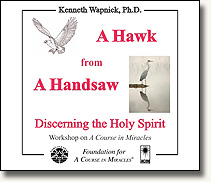

“The ark of peace is entered two by two, yet the beginning of another world goes with them.”
Lyn Corona, president
TimWise, vice president
Since its founding in 1990 the Ark of Peace has served hundreds of individuals through teaching, healing, and community service. Throughout these diverse forms the single purpose has remained awakening from the dream of separation through the Course’s unique form of forgiveness.
* If there is a specific place/cause you would like your donation to be applied to, please mention it in the notes box upon payment.*
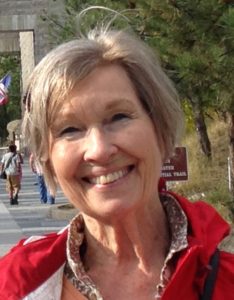
Dear friend of School for A Course in Miracles,
I want to take a moment to let you know how much we appreciate your monthly contributions to School for A Course in Miracles.
Most importantly, by your generosity you join us in our common purpose of learning forgiveness and freeing yourself and your brothers from misunderstanding and the hate that ensues. A peaceful mind is not a little gift. Through our joint sharing we hope to accelerate this process. Together we are part of a greater purpose than the one we once came to this world for.
Secondly, regular monthly donations are an important part of our overall financial stability because they enable us to budget with certainty. Regardless of the amount you are able to contribute your regular contribution is very helpful to us and we thank you for it.
If you are not yet a regular contributor and would like to be one, here is how you go about it:
About our regular online classes.
We have online classes on Saturday and Tuesday mornings at 9:30 am, and Thursday evenings at 6:30 pm. They are accessed through our Zoom classroom link which can be found on every weekly news post or by going to the website and finding any online class. The link is always the same.
Every earnest student is welcome to attend. We do not make specific charges for these classes. Instead, if you find value here, we hope you will consider making a monthly donation to support School for A Course in Miracles.
About donations.
School for A Course in Miracles is the teaching order of Ark of Peace, a 501 © (3) nonprofit organization founded in 1990 to support and extend the teachings of forgiveness set forth in A Course in Miracles. In the Course, the ark of peace symbolizes the truth that remains as we release others from our mistakes and honor them as they are. “You made him not; no more yourself. And as you free the one, the other is accepted as he is.” L. 200
We thank you for choosing School for A Course in Miracles for your Course education.
With appreciation,
Lyn Corona

by Gloria Wapnick
and Kenneth Wapnick, Ph.D.
Although the term resistance appears infrequently in A Course in Miracles, it is nonetheless a key concept in the process of students learning the mind-changing lessons of forgiveness that are the Course’s central teaching. Indeed, it is the only concept that can satisfactorily explain a phenomenon experienced by most (if not all) students of the Course at some point or another in their work with it. This is the seeming paradox, on the one hand, of consciously and most sincerely attempting to learn, live, and practice the Course principles under the guidance of Jesus or the Holy Spirit, while on the other hand, experiencing the ongoing frustration of not doing just that. Most spiritual seekers are familiar with the famous words of St. Paul, who exclaimed out of this same sense of frustration: “For the good that I would I do not: but the evil which I would not, that I do” (Romans 7:19). This article explores the issue of resistance in Course students’ efforts to put into practice its principles of forgiveness as taught by their Inner Teacher, the Holy Spirit.
As with so many other areas that touch on the process of healing in A Course in Miracles, the work of Sigmund Freud offers us many parallels which underscore the importance of understanding the dynamics of the problem and its solution. Very early in his psychoanalytic work, Freud observed that his patients were not improving, despite the insights he was offering them as to the cause of their neurosis. It eventually dawned on him that the problem lay in the fact that the patients did not want to get better, a dynamic he termed resistance:
…the [therapeutic] situation led me at once to the theory that by means of my psychical [i.e., psychological] work I had to overcome a psychical force in the patients which was opposed to the pathogenic ideas becoming conscious…. This work of overcoming resistances is the essential function of analytic treatment…. (Studies on Hysteria by Freud (with J. Breuer), 1893, Vol. II, p. 268; Introductory Lectures on Psychoanalysis, 1917, Vol. XVI, p. 451).(1)
